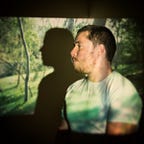5. Underoath: Still standing solemnly in the woods
The screaming music trilogy, part 1
So now we get to the first artist that shaped me for the worse.
I remember the day metalcore died. I was at Warped Tour in Columbia, Maryland. There were so many screamo bands who had identical hairstyles and outfits I couldn’t possibly have told them apart. Literally everyone, their Grandma, and the Queen of England was in a metalcore band. I distinctly remember one moment when I sat down in the grass for a bit a ways from the action. I could hear about five bands playing, and all five of them launched into identical blast-beat breakdowns at the same time. It was a parody of itself.
I’m not going to parse genres here, but the end of Warped Tour felt like that last gasp of a strange trend during my teenage years when screaming bands were all the rage. I call it “the era of standing solemnly in the woods”.
Underoath was one of the biggest bands of this wave.
Looking back, I have to say I was more fascinated by metalcore than I enjoyed it. I always felt like an observer of that scene, not a member. I could never listen to more than a few songs at a time before the blast beats and screaming just got grating and redundant. When there are no valleys there are no peaks.
Going back through Underoath’s discography, it seems even more homogeneous than I remember. Later trends in music were brought on by artists like Twenty One Pilots who were inspired by the energy of metalcore and not necessarily the sound. And that’s where metalcore got me — the energy, not the sound. Bands like Underoath got me pumped up for workouts (specifically when I was getting in shape for the military).
Bands like Underoath did not make me a better person. I ain’t no new-age hippy, but there’s a discernible difference between negative and positive energy, and Underoath was awash in negative energy. They and their peer artists made life feel much darker than it actually was, especially in my angsty teenage years. I would’ve been better off with something more life-affirming.
And let me tell you, many of the people in these bands — many of whom marketed themselves as “youth group friendly” — have a pretty terrible track record of hardcore drugs, burnout, and hiring hitmen to kill their wives.
I know what their defenders will say. “Music like theirs helped me process negative emotions in my life.” Maybe so, but I found the opposite to be true. When I stopped stuffing my head with their negativity, my life got better.
This all reminds me of an conversation about 90s gangster rap: were artists like Tupac and Dre glorifying or condemning the lifestyles that shaped them? The same could be asked about excessively negative bands like Underoath. I would argue that Underoath’s f-bomb free version of negativity is a subtle and more narcissistic form of many of the same toxic mindsets in gangster rap. It encourages you to mellow in negative emotions. If you’re not careful, you’ll get locked in them.
Now I want to be clear: This may be a mildly controversial thing to say, but I definitely think there is a place for screaming in music. Art can and should be a place to process negative emotions in certain settings. But it’s all about context. I’ll explore that more in my next couple pieces on screaming bands.
If I had to pick a favorite Underoath song, Paper Lung would be number one. It’s a slow burn with a brutal climax.
If you’ve read this far, you’re definitely an interesting and thoughtful person. Follow me on Instagram and Twitter.
